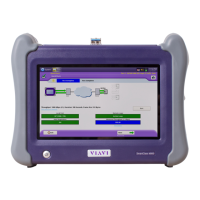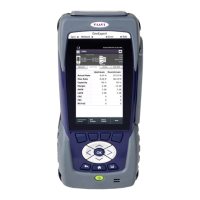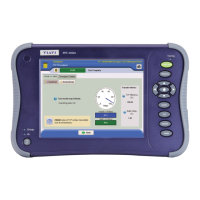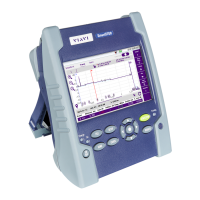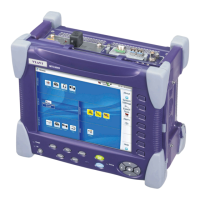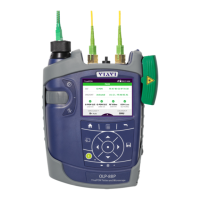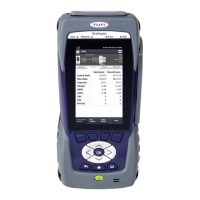
Do you have a question about the Viavi T-BERD MTS 5800-100G and is the answer not in the manual?
| Brand | Viavi |
|---|---|
| Model | T-BERD MTS 5800-100G |
| Category | Test Equipment |
| Language | English |
FCC compliance statement for Class A digital devices, including operational conditions and interference mitigation.
Industry Canada compliance statement for license-exempt RSS standards, including operational conditions and interference mitigation.
Describes the T-BERD/MTS MSAM, CSAM, 5800, 5800-100G, and Smart Class 4800/4800P as all-in-one test solutions.
Lists instrument features like electrical/SONET/SDH/Ethernet/FC/OTN interface support and optical power measurement.
Explains that instruments are factory-configured and how to discuss specific configurations.
Describes the T-BERD/MTS 5800 and SC 4800/4800P as rugged, portable test solutions.
Describes CSAM usage with 6000A or 8000 base units and DMC chassis.
Describes MSAM usage with 6000A or 8000 base units and DMC chassis.
Describes DMC chassis usage with T-BERD/MTS 8000 base unit for testing multiple circuits.
Instructions to review before unpacking and assembling instrument components.
Details key principles and base unit requirements for connecting a DMC to a base unit.
Steps for inserting MSAM or CSAM modules into the 6000A base unit or DMC chassis.
Instructions for inserting, removing, and swapping Physical Interface Modules (PIMs) in the MSAM.
Procedure for attaching optional expansion modules to specific instrument models.
Guidance on inserting and removing CFP adapters and transceivers.
Provides guidance on inserting and removing SFP, SFP+, XFP, and QSFP+ transceivers.
Principles for secure connection and avoiding damage when connecting/disconnecting components.
Checks base unit requirements before connecting a DMC to ensure compatibility.
Checks MSAM compatibility with DMC and power supply requirements.
Checks CSAM compatibility with 6000Av2 base unit and power supply requirements.
Step-by-step guide for inserting MSAM or CSAM modules into the instrument.
Steps for inserting PIMs into the MSAM ports, ensuring correct compatibility and orientation.
Steps for inserting CFP adapters into CSAM ports to provide physical interfaces.
Details how to power the instrument using battery or AC adapter, and verifying correct adapter.
Instructions on launching MSAM or CSAM modules, including BERT icons and system screen navigation.
Describes the instrument's user interface elements like Menu Bar, Soft keys, and Result Windows.
Covers tasks like loading software, setting screen saver, specifying printer, and VNC password.
Guidance on connecting the instrument to the circuit, considering older/newer chassis and PIM requirements.
Recommendations before testing, including verifying cables and determining synchronization needs.
Methods for selecting a test application using Quick Launch or Test Menu.
Process of displaying setup screens, specifying test settings, and saving configurations.
Basic instructions for connecting the instrument to the circuit for testing.
Steps to start a test after configuration and connection, including laser control.
How to view test results in Results Windows, including grouping and layout options.
Guidance on running multiple tests simultaneously to reduce testing time.
Process for formatting, creating, storing, and printing reports with optional screen shots.
Explains how synchronization with external timing references improves measurement accuracy.
Detailed steps for connecting the TM4-M GPS receiver to various instrument models.
Factors to consider before optical circuit testing, including optics and transceiver details.
Steps to run the Optics Self-Test and Cable Test applications.
Allows selecting and running pinned and recently used tests quickly.
Steps to display setup screens by selecting a test application and then the Setup soft key.
Steps to set result group and category using Group and Category buttons.
Steps to schedule a timed or delayed-start timed test, specifying duration and time.
How to specify details like owner, serial number, technician name for the report header.
Steps to launch the utility on the instrument and workstation for remote access.
Procedure to launch the utility on the instrument to obtain the remote access code.
Steps to enable Bluetooth, allow pairing, and find devices for connection.
Details the use of the Viavi fiber microscope accessory for fiber inspection.
Explains how to use the Optical Power Meter accessory for power measurements.
Steps to connect and use the fiber microscope for inspection.
Provides detailed specifications for T-BERD/MTS 5800 and SC 4800 instruments.
Lists specifications for the MSAM and its available PIMs.
Details specifications for jitter and wander measurements for MSAM and T-BERD/MTS 5800.
Provides specifications for the CSAM module.
Provides guidelines for maintaining the rechargeable lithium-ion battery for T-BERD/MTS 5800 and SC 4800.
